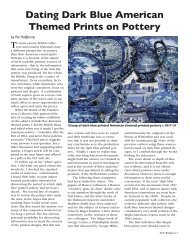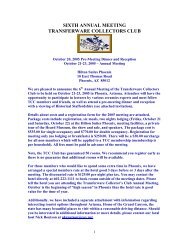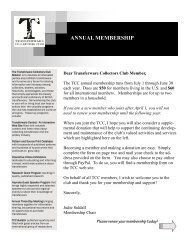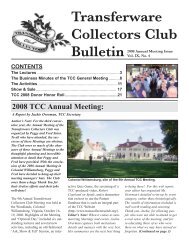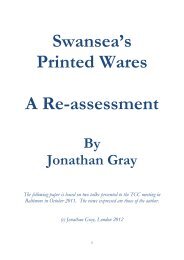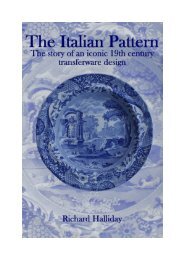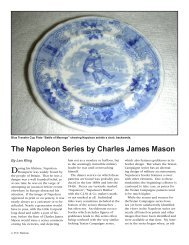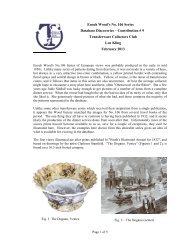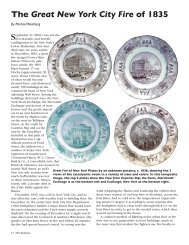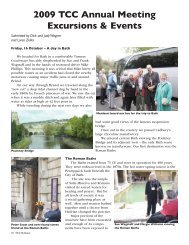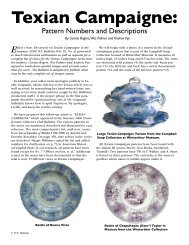download the publication - Transferware Collectors Club
download the publication - Transferware Collectors Club
download the publication - Transferware Collectors Club
Create successful ePaper yourself
Turn your PDF publications into a flip-book with our unique Google optimized e-Paper software.
“In 1790 one of <strong>the</strong> ‘throwers;’ was Charles Stevens, who had been an<br />
apprentice (at <strong>the</strong> same time as William Taylor) at <strong>the</strong> Worcester China<br />
Works. In that year he applied to be employed at <strong>the</strong> Derby China works<br />
sending his address as ‘The Pot Works, Swansea’ and next at Mr<br />
Rothwells, engraver at The Strand, Swansea.”<br />
Morton Nance was of <strong>the</strong> opinion that Rothwell had been in Swansea for<br />
some time before 1790 although no earlier reference to his presence has<br />
been found. He was still in Swansea in 1792 provable not only because of<br />
his dated topographical engravings but also because of <strong>the</strong> announcement<br />
in The Glocester (sic) Journal of <strong>the</strong> auction of a dwelling with garden and<br />
stable in Somerset Buildings situated in <strong>the</strong> borough near to <strong>the</strong> Pottery,<br />
<strong>the</strong>n rented by Thomas Rothwell. It is not known whe<strong>the</strong>r <strong>the</strong> new<br />
landlord would have retained Rothwell as a tenant or whe<strong>the</strong>r Rothwell<br />
<strong>the</strong>n sought residency elsewhere in Swansea. Rothwell’s house was only<br />
one of 17 houses which were put up for auction. Rothwell’s house was at a<br />
yearly rent of fourteen guineas, a considerable amount at <strong>the</strong> time. This is<br />
an indication both of his financial state and his status within <strong>the</strong> Pottery<br />
hierarchy. The fact that Thomas Rothwell is mentioned by name in <strong>the</strong><br />
newspaper is an indication of <strong>the</strong> esteem in which he was held, o<strong>the</strong>rwise<br />
why mention his name?<br />
As principal engraver he would have been responsible for producing <strong>the</strong><br />
patterns for <strong>the</strong> copper plate engravings for most, if not all, of <strong>the</strong> early<br />
transfer printed ware of <strong>the</strong> Cambrian Pottery. The policy at <strong>the</strong> Cambrian<br />
Pottery seems to have been that copper plates weren’t signed because so<br />
far none in this early period have been found signed. It is possible, to<br />
identify some of his engravings for ceramics by comparing <strong>the</strong>m with<br />
known and signed Rothwell engravings. He certainly signed his<br />
engravings in Liverpool and Staffordshire. Although we know Rothwell<br />
was also an enameller it is not possible to identify any of his work as no<br />
records exist.<br />
That <strong>the</strong> first three engravings were published by Coles and Haynes but<br />
not <strong>the</strong> o<strong>the</strong>rs is easily explained, as Gibbs and Morris state that:<br />
“he retained a measure of independence from <strong>the</strong> pottery in his work as an<br />
engraver because of his personal friendship with Haynes”.<br />
There seem to be no original drawings of Rothwell’s topographical<br />
engravings but two oil paintings of Oxwich which are reputed to be by<br />
5



